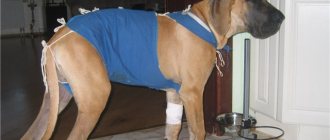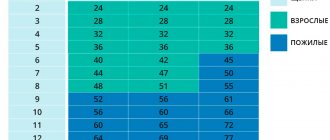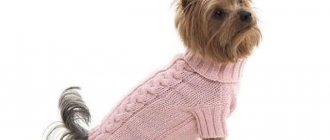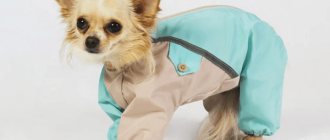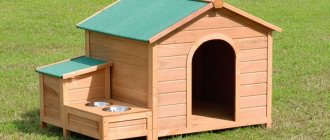How to determine your dog's clothing size
How to measure your dog correctly and choose the right size?
To determine the correct clothing size, you need to take measurements of three parameters:
Back length
Make sure the dog is standing straight. Using a flexible tape measure, measure the length along the spine from the withers (the highest point of the back of a calmly standing dog) to the base of the tail. The resulting size in centimeters will be the size of your dog. If the resulting length is between sizes, it is recommended to consider the size upward. If the dog is heavyset, with a voluminous chest, it is recommended to add one size so that the item fits properly and the dog is comfortable. If the dog is puny or lean, a smaller size is desirable.
Bust
Measure the widest part of your dog's chest. It is usually located just behind the front paws. When determining the size, it is recommended to add 3-5 cm to the resulting volume for a loose fit. We also advise you to pay attention to the chosen model - depending on the style, material or your desire, things can be either tight-fitting or quite loose.
Neck circumference
Measure the widest part of your neck. Usually the neck circumference is equal to the size of the collar. When determining the size of a particular model, we advise you to pay attention to the neck of the product - items can have a high collar or a fairly spacious neck. In any case, the thing should not “choke” the dog. When using a table of clothing sizes for dogs, focus primarily not on the breed of your dog, but on the sizes you obtained when taking your pet’s measurements!
When using a table of clothing sizes for dogs, focus primarily not on the breed of your dog, but on the sizes you obtained when taking your pet’s measurements!
For your convenience and more accurate size selection, you can indicate the size of your pet in the comments to the order. Our managers will select the appropriate size.
The size chart was created specifically to make it easier to select and purchase clothes and shoes for dogs.
Collar size chart
To select the correct collar size, measure the circumference of your neck with a tailor's tape, placing two fingers under it. Since there are additional holes on the collar tape, add 5-7 cm to the result. It is important that the accessory is not too short and does not restrict breathing.
The size chart for dog collars uses the same designations as socks.
| Designations | Collar length, cm |
| XXS | 25 |
| XS | 30 |
| S | 37 |
| M | 42 |
| L | 51 |
| XL | 56 |
| 2XL | 61 |
| 3XL | 66 |
I hope that the article was useful to you. I will answer questions in the comments.
Clothing size chart
ATTENTION! The dimensions given are approximate and may differ between different manufacturers and depending on the style of the product.
| Size | Neck circumference (cm) | Chest (cm) | Back Length(cm) |
| XS | 18-20 | 28-32 | 18 |
| S | 22-26 | 36-40 | 24 |
| M | 27-30 | 40-44 | 30 |
| L | 30-34 | 46-50 | 32 |
| XL | 34-38 | 52-56 | 35 |
| 2XL | 38-43 | 56-60 | 40 |
| 3XL | 43-48 | 58-64 | 45 |
| 4XL | 47-52 | 64-70 | 48 |
| 5XL | 52-57 | 70-76 | 52 |
| 6XL | 57-62 | 76-82 | 56 |
| 7XL | 62-67 | 82-88 | 60 |
| 8XL | 67-70 | 88-92 | 66 |
| 9XL | 70-75 | 92-100 | 70 |
| 10XL | 75-79 | 100-108 | 74 |
| 1 | 20-22 | 25-30 | 19 |
| 2 | 20-24 | 29-36 | 23 |
| 3 | 23-28 | 35-42 | 28 |
| 4 | 27-31 | 41-47 | 31 |
| 5 | 30-34 | 46-53 | 35 |
| 6 | 37-42 | 55-59 | 39 |
“Get this off me!” or how to train a dog to wear shoes?
Finding high-quality and comfortable shoes is not so bad, but sometimes it’s very difficult to train your dog to walk in them. It is best to start putting shoes on your pet at a young age - at five to six months. And the older the dog, the greater the likelihood of categorical resistance.
For your first acquaintance with such an accessory, choose very soft, lightweight shoes with thin soles, for example, knitted, fabric or thin suede.
When teaching your dog to wear shoes, be patient, use toys and treats. The dog will try to take off his shoes, and you should distract him with treats and toys.
Under no circumstances should you punish your pet for trying to get rid of these “obscure” things. And when the dog stops trying to take them off and starts running around in them, be sure to praise him and treat him with a treat.
If the dog calmly walked around the house in shoes for 10-15 minutes, then you can safely go for a walk outside with him!
By the way, this story makes me want to cry with emotion... A girl adopted a 17-year-old touching gift from fate
Liked? Be sure to subscribe to us on OK, VK, Zen and FB
Source
Shoe size chart
| Size | Sole length (cm) | Width(cm) | Note |
| 1 | 4 | 3,5 | Shoes for mini dogs up to 1.7 kg: Chihuahua, toy terrier, mini Yorkie, small breed puppies |
| 2 | 4,5 | 4 | Shoes for small dogs up to 2.5 kg: Yorkshire Terrier, Toy Terrier, Maltese, Japanese Chin, Pomeranian |
| 3 | 5 | 4,5 | Shoes for dogs up to 4 kg: Chinese Crested, Pug, Toy Poodle, Large Yorkie, Shih Tzu, Miniature Pinscher |
| 4 | 5,5 | 5 | Shoes for dogs up to 6 kg: Miniature Poodle, Shih Tzu, Fox |
| 5 | 6 | 5,5 | Shoes for dogs up to 8 kg: Miniature Poodle, Shih Tzu, Fox |
| 6 | 6,5 | 6 | Cocker spaniel, poodle |
| 7 | 7 | 6,5 | |
| 8 | 7,5 | 7 | |
| 9 | 8 | 7,5 |
Features of ideal shoes
The height of the boot - the boot allows you to firmly fix the paw, its height depends on the size and build of the pet - the taller and larger the dog, the higher the boot should be.
Sole – it is advisable that the boots have a polyurethane sole with tread and a slight bend. Thus, the paws will be reliably protected and excellent grip on any surface is guaranteed.
Fastener – shoes can be lace-up, strap or zipper. There must be at least two straps so that the boot does not slip off. It is not recommended to take shoes with zippers for long-haired breeds - hair may get caught in the lock.
Weight. The weight of the shoes should correspond to the size and build of the dog. The dog should feel comfortable and relaxed, run freely and not be distracted by “things” on its paws.
Decorations. Indeed, the brighter and more original the shoes, the more unique and attractive the dog becomes. But you should know that the fewer accessories, the lighter and more comfortable the boots.
Warmth - pet stores offer a large selection of fur-lined boots. In fact, there is no need to buy a “winter” version, since only the paws have sweat glands. In warm shoes, your feet will swell and sweat.
If your pet is cold, it is better to purchase a suit or blanket.
Note!
Shoes must be:
- thin at the bend of the paw so that the dog does not feel like a person in ski boots;
- without internal seams, as they can rub the paws;
- with a thick toe, otherwise your pet’s claws will turn your shoes into a sieve after the first walk.
Varieties
A number of factors underlie the classification of dog shoes. We have to study each of them in order to better understand the types of such an important accessory and be able to choose the optimal model.
First of all, shoes for dogs differ by season:
According to their purpose, the following varieties are distinguished:
Shoes for dogs are created in a wide variety of variations. For summer, sandals are most suitable; in bad weather, you can wear boots or sneakers, and for winter, boots are the best choice. These accessories are made from a variety of fabrics: cotton, leather, polyester, suede, silicone, neoprene. The materials used must be soft and hypoallergenic. There should be a soft lining on the inside that will prevent the paw from slipping.
The sole is rubberized and grooved for better grip on various surfaces. The toe box in such shoes is made denser, which will prevent claws from piercing the material. Elastic bands, fasteners and Velcro are used to secure the paw.
Models with luminous soles are very popular. It is convenient to walk your pet in such shoes in the dark, since he will always be in sight.
Knitted shoes are becoming increasingly popular. You can make such an accessory yourself if you have at least minimal skills in working with knitting needles or crochet. Knitted patterns are only suitable for home use.
Although, if you make knitted, openwork boots from light material and sew dense material onto the sole, then they can be worn outside in good weather.
The most common shoe sizes for dogs are indicated by numbers from one to five.
The first shoe size has an average length of 4 cm, width of 3.5 cm and is suitable for dog breeds:
- chihuahua,
- Toy Terrier,
- mini York,
- Yorkshire Terrier,
- for puppies of small breeds.
The second size has an average length of 4.5 cm, width of 4 cm. These shoes are worn:
- yorkshire terriers,
- toy terriers,
- Maltese,
- Pomeranian Spitz.
The third boot size, 5 cm long and 4.5 cm wide, suits the following dog breeds:
- Chinese Crested,
- pug,
- toy poodle
- large York,
- shih tzu,
- miniature pinscher.
The fourth size, which is 5.5 cm long and 5 cm wide, is worn by dogs of the following breed:
- miniature poodle,
- shih tzu,
- Fox.
Shoe size 5 is suitable for a cocker spaniel or poodle. The average length of the fifth shoe size is 6 cm, and the width is 5.5 cm.
After taking measurements from your pet's paws and choosing the size of boots, shoes or slippers, you must try on the shoes.
Is the shoe size you have chosen suitable for your dog
, can be determined by the behavior of the animal. If the dog behaves normally within ten minutes after trying on and does not try to remove the shoes, the shoes fit.
Nowadays, no one will be surprised by the sight of a dog walking down the street in stylish clothes and boots. Many may think that this is just a whim of the owners paying tribute to fashion. In addition, dog experts never tire of repeating “stop humanizing dogs.” People's needs and desires should not be attributed to it.
From this point of view, various dresses, jackets, hats, boots and sandals for your beloved pet are meaningless and unnecessary attributes.
But there are situations when dogs really need shoes.
• In winter, sidewalks in cities are generously sprinkled with special reagents and salt to prevent the formation of ice. If aggressive chemicals come into contact with a dog’s paws, the reaction occurs instantly. By the time you get home to wash your paws, your dog will already have irritation of the delicate skin between the paw pads or even a burn. Getting into the cracks on the paw pads, they lead to the appearance of non-healing wounds, which becomes the cause of the development of various infections and diseases.
• Wet snow gets stuck between the toes, very quickly forming ice lumps that rub and injure the skin. The build-up of ice is uncomfortable for your pet, causes discomfort, interferes with movement, and can sometimes lead to injury. The dog begins to limp and refuses to go further - it hurts. This is especially true for animals with thick fur on their paws.
• The pads are very easily injured by the ice. Microcracks and often serious cuts appear. So the boots protect the paws from physical and mechanical damage
• Dogs of decorative breeds, whose paw skin is very delicate and sensitive to cold, need protection from frost in winter - they simply need boots
• And of course, the shoes protect the paws from dirt, which is undoubtedly a big plus - the dog’s paws remain clean and do not require daily washing. In addition, it is very convenient when visiting.
In what cases can you do without shoes?
1. You live in a warm climate or outside the city and your streets are not sprinkled with chemicals and salt.
2. Walks are short and you avoid walking on the sidewalks, where the main accumulation of reagents is.
3. Enjoy washing your paws after walks
4. Some dogs are completely impossible to train to wear boots. In this case, you will have to walk without them and use other means of protection, such as paw wax
WHAT SHOES ARE THERE?
Shoes for dogs, just like for people, come in a wide variety of models and purposes. There are models for everyday walks, seasonal shoes, and there are glamorous options for fashionable dogs. It is advisable to purchase several pairs of shoes for your pet for all seasons and occasions.
Winter boots with fur or uggs
In regions where cold and long winters cannot be avoided without fur-lined boots with grooved rubber soles. These shoes will protect your paws from frost, snow, sticky ice, injury from ice and reagents, and will provide a comfortable walk on cold days.
Suitable for the coldest days or even weeks when warming is not expected soon. They are a mini-analogue of human shoes, taking into account the anatomical structures of the animal’s paws. Sewn from natural sheepskin, which warms from the inside, and suede protects from the wind. They have special supporting Velcro or zippers to hold the boots on the dog’s paw.
Such shoes are not suitable for slushy weather, as they will get wet.
Boots
The main function is protection from moisture and reagents. Perfect for rainy weather and also for winter to protect paws.
There are 2 types of boots - rubber and winter insulated
Good winter boots must be made of waterproof leatherette material or thick fabric - impregnated raincoat fabric, and also be equipped with several fasteners, zippers and Velcro to fit snugly to the paw and not slip off. The corrugated rubberized sole will help the dog keep its balance on slippery paths and not slide.
Rubber or silicone boots are comfortable in rainy or slushy weather. The dog will not be hot in them, but the paws will remain dry and clean. Nowadays in stores you can mainly find such models made in China - they are short-lived, but they are distinguished by their low price and funny appearance.
Latex pads
Perfect for dogs who don’t want to wear shoes, but protection from reagents and water is necessary when walking. They are also very convenient for owners, since they do not have fasteners and zippers, like regular boots. They are easy to put on, hold well and do not fall off. These shoes look like socks or balloons ending with thick elastic bands. The foot pads do not hinder movement, which will appeal to any dog, even the most shoe-averse dog. True, these shoes quickly become unusable, as they are damaged by claws or worn off on the asphalt. So it’s better to immediately purchase such “socks” for future use. Fortunately, the pads are sold in packages that already contain several sets.
Socks with rubberized soles
They may also be suitable for the winter season, when the weather is dry and frosty. If the walk is not long, then a protective layer is enough to avoid getting wet. At the same time, the paws remain clean and protected from chemicals and cold. The latter is more relevant for small dogs. The socks are fixed on the foot with Velcro, which wrap around and prevent the shoes from falling off
Summer shoe options
They can be special sandals, sandals made of breathable fabric. Such shoes can be considered overkill, but they can be considered practical if there are cracks or cuts on the soles. Protects against dirt and infection getting into wounds. And also, on a hot summer day, it will protect the damaged paw from surfaces heated in the sun.
HOW TO CHOOSE SHOES FOR A DOG
When choosing shoes for your pet, you should start from important criteria - the material from which it is made and the size.
Synthetics can rub the skin, cause discomfort, and cause allergies, so it is better to give preference to high-quality natural materials.
Be sure to inspect the boots with your hands. There should be no uneven or protruding seams, pilling, or stitches inside. The surface must be smooth, otherwise it will rub the foot. Make sure the sole is level, otherwise the paw will fall over when walking.
And most importantly, it is best to try on several shoes at once in the store. Choose the right shoes to understand which model and size is ideal for your dog, and then purchase the same ones in online stores without fear of making a mistake with the size.
It is more convenient to choose models with Velcro, zippers or fasteners. The presence of decorative elements on shoes should be minimized - the lighter the shoes, the more comfortable it is for the dog.
*The most important thing is to choose shoes that will fit tightly on your paw, not restrict movement, and be comfortable*
DETERMINING THE SIZE
The second important issue in choosing shoes for your pet is determining the correct size. Otherwise, the dog will be constrained in its movements and may constantly lose its shoes or rub calluses. To determine the size, it is enough to know the length and width of your pet's paw, measured at the longest and widest point of the paw print, respectively.
Another way is to place the dog's paw on a piece of paper and draw an outline. Using a centimeter, measure the length of the drawn paw: the distance from the back heel to the tip of the longest claw, add 0.5 cm to the result (the claws straighten when walking). In the case of small breeds, the “reserve” should be less. Then measure the width of the paw: from the tip of the outer toe to the tip of the inner one. Be sure to take measurements from both the front and back paws; they tend to differ in size.
In the future, before purchasing, determine the size of your dog’s shoes using the manufacturer’s table for the model you like.
Since there is no single size chart for shoes, each manufacturer has its own.
IMPORTANT!
If the width and length of the paw are between two sizes, choose the one that is larger. And don’t forget that the inner size of the shoe is a couple of millimeters smaller than the outer one.
Choosing boots for dogs
When choosing clothes for pets, many people wonder how to determine the size of a dog's shoes. After all, without boots or slippers, it will be cold for the dog to walk in the snow. This is especially true for animals of small breeds and sensitive to temperature changes. Also, such wardrobe items help to avoid contamination of paws, which means you will get rid of marks on the floor and daily washing of your pet.
Choosing shoes for a dog: All sizes of boots for dogs vary depending on the breed of the animal. Typically, the length of the sole is 0.5-0.7 cm greater than its width. A table of shoe sizes, including the one presented on our website, will help you choose the right pair.
If you don’t know how to determine the size from the table, then find the breed of your dog in the far right column. The two numbers on the left indicate the length and width of the sole, and the leftmost number is the size designation in the international classification.
Why does the owner need to know the height of the dog at the withers?
When assessing the size of an animal, three main parameters are taken into account:
- height at withers;
- oblique body length;
- metacarpal girth.
In addition, you need to know where the dog’s withers are and be able to measure his height in order to:
- accurately determine the required jump height during sporting events;
- be able to compare the pet’s parameters with the standard requirements for the breed’s exterior;
- promptly detect deviations in the development of a growing individual;
- knowing the size of the dog, choose accessories of the appropriate size, clothes, carrier, bed, etc.;
- carry out medical manipulations - subcutaneous injections are placed in the withers, a vaccine is administered, insecticidal preparations are applied.
Since the subcutaneous fatty tissue of the nape is literally penetrated by blood vessels, this allows the active substances of the drugs to be perfectly absorbed. And thanks to low sensitivity, the procedures are painless and with minimal discomfort.
A large number of vessels increases the effectiveness of remedies against external and internal parasites. In addition, the dog is not able to lick the area where the medication is applied.
Let's put our favorite paws in boots! How to choose the right shoes for your dog?
A dog needs shoes for the same reasons as a person: to protect them from dirt, glass, thorns, infections in wounds, and freezing. Finding comfortable boots for your pet is not an easy task, but today we will try to give you practical advice, guided by which you will cope with it perfectly.
Types of outfits
Clothing for purebred small dogs comes in several types of products. Such wardrobe elements will help keep your pet warm in winter, while he will remain beautiful and stylish. The most common types of outfits include:
- blanket;
- kits;
- overalls.
A blanket is a small product that is put on the dog over the head. It will be an excellent alternative to various blouses that cannot be worn on a pet due to its excessive activity. The blanket does not hinder the dog’s movement, because it is located on the neck, covers part of the body and does not affect the paws. Depending on the gender of the dog, stores offer a variety of colors: blue, light blue, pink, yellow, green. You can also find original prints on the fabric, which will make your dog stylish on a walk.
Clothing sets for small dogs consist of several wardrobe elements: pants, as well as a sweater or jacket. The latest piece of dog fashion is usually made of waterproof fabric similar to a thick raincoat. It would be good if the bottom of the jacket was equipped with a warm lining for the cold season. Sweaters replace jackets; they are purchased for the off-season - for walks in spring and autumn. Pants are the favorite clothing of small dogs. They go great with a jacket or sweater, the only problem is putting the pants on your pet. Most dogs categorically refuse to wear this wardrobe item.
Jumpsuits are considered the most common types of outfits for modern miniature dogs. They are easy to put on, do not restrict your pet’s movements, and are made of protective fabric. In overalls, a terrier or Yorkie will be comfortable in winter, spring and summer. The pet will not get dirty and will come back from a walk clean and tidy. Overalls are equipped with zippers or buttons that fasten on the stomach or back.
How to accustom your pet to shoes?
Don't expect your pet to show joy from a new accessory. The dog needs to be accustomed to wearing shoes; this process will not be easy. You can start training to wear shoes only after 5 months, and in some cases even after 9 or even 12 months. Until this time, the paws are still developing, so shoes can lead to deformation of the limbs.
You need to accustom your pet to wearing shoes gradually and always at home. A few minutes will be enough to get started. The dog will try in every possible way to remove the shoes. She needs to be distracted from this process; you can use treats or rewards. You shouldn’t scold your dog for trying to take off his shoes.
Over time, the pet will get used to its accessory and will not even be distracted by it.
Only after this can you take your pet outside in full equipment.
To learn how to choose shoes for dogs, watch the following video.
All rights reserved, 14+
The use of any materials without our prior written consent is prohibited.
Source
When is it recommended to wear clothes?
People have bred many ornamental animals, for some of them the scorching sun and cold are destructive. For example, a miniature pinscher must wear clothes both in summer and winter. The Labrador, which has a thick coat, requires regular grooming and therefore needs comfortable clothing. Small dogs have a much higher heat transfer rate than large breeds. Because of this, your pet can easily catch a cold in a draft or get sick if it gets cold. Short-haired dogs do not have an undercoat, and clothing is the only way for them to protect themselves from adverse weather conditions.
Owners of four-legged animals often resort to grooming services.
During grooming procedures, pets are given short haircuts. Because of this, a sharp disturbance in heat metabolism occurs in the animal’s body and the likelihood of illness increases. Note! Professionals warn that your pet needs to wear clothes for some time after visiting the grooming salon.
The body of animals undergoes numerous changes with age. Older dogs have problems with thermoregulation, they often get cold and experience problems with arthritis. Such animals should be protected. It is very important for owners of older dogs to take care of their pet and create a suitable wardrobe for it.
A nursing mother should absolutely not freeze. Her mammary glands should be warm. Otherwise, mastitis may occur.
Clothing for dogs not only protects their health, but also protects them in bad weather. A raincoat allows your dog to stay dry and clean. Even if it is raining outside, the breeder will not have to bathe the animal completely; it will be enough to wash the paws. In addition, in winter, roads are sprinkled with reagents that can provoke an allergic reaction. In this case, boots will protect the dog’s limbs from harmful effects.
On a note! Not all animals are suited to living in a booth. Today's popular floor coverings (tiles, parquet boards, linoleum and laminate) are dangerous and inconvenient for pets. Socks with stoppers for babies and adults will be truly comfortable.
Special dog panties designed for the period of estrus not only prevent mating, but also protect the house from secretions appropriate for this period.
Pet clothing also brings a lot of positive emotions to breeders. Dogs walking in dresses and suits evoke delight and tenderness not only among their owners, but also those around them.
This is interesting! Some caring owners sew costumes for adult pets and puppies with their own hands.
High-quality clothing will keep your pet from freezing

